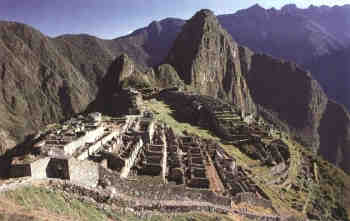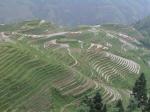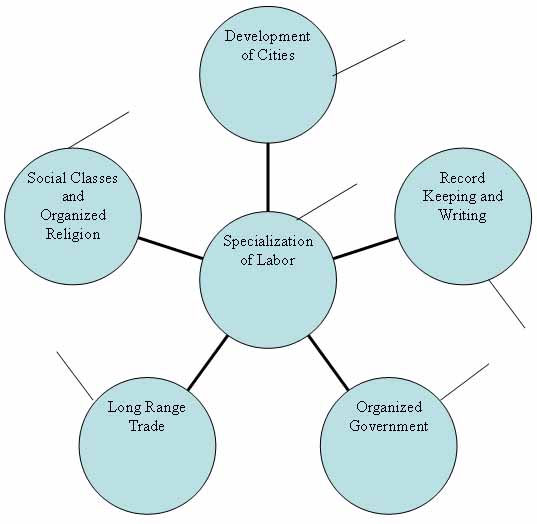Activity 3
Essential Question
- What are the distinguishing characteristics of a complex society?
Background
In many places, the resulting improvements in agricultural technology helped to produce a surplus of food which enabled some members of the community to engage in occupations other than farming. This, in turn, resulted in further innovation and the production of trade goods. For many people the quality of life improved. All of these changes encouraged population growth. Over time, as the population grew, the level of collective learning grew with it, resulting in ever more innovation and specialization. Communities soon crossed a threshold of size and complexity that required new, more complex ways of social organization.

Ancient Inca Irrigation Works
Instructional Strategies
 |
Strategy 1 |
Gathering Information: Using Artifacts, Pictures, and Text to Learn About Civilizations
Have students work in small groups to examine pictures, artifacts, and related text that illustrate aspects of an early complex society. The following website might be a good starting point for their research:
http://www.uwgb.edu/galta/a100/lectures/lect9.htm
Use a graphic organizer to help students take notes on their research. For example, a mapping activity helps students to brainstorm ideas. Add additional lines as needed to take notes
 |
Strategy 2 |
Extending and Refining Information: Deductive Reasoning
Have the students use their notes to answer the following questions. Use a think/pair/share before involving the whole group.
- Why was the development of cities an important indication that a civilization was growing and expanding?
- How does the specialization of labor lead to a more complex society?
- Why is an organized government so important to the development of civilizations?
- What part does religion plan in a civilized society?
- Why do social classes develop as a society becomes more complex?
- Why is trade important to the continued growth of a civilization?
- What role does communication play in helping a civilization grow and expand? Why is record keeping important?
Have students go to the media center to find pictures of early developing civilizations. Make each student responsible for bringing one picture to class for discussion. Have them use the following information chart to organize their presentation.
| Development of Cities |
Social Classes | Religion | Organized Government |
Trade | Writing | Labor |
|
|
|
|
|
|
|
Be sure students select pictures that provide information in several of the categories above. Have them record information in the appropriate categories.
As the students make their presentations, make a master list showing the supporting data for each of the characteristics of a complex society. Display this list in class on the bulletin board and refer to it often during the course of the unit.
 |
Strategy 3 |
Application
Have students review the characteristics of a complex society. Ask them to think about our own society today. Which of these characteristics are still valid today?
- Is the development of cities still important today? Do cities play as important a role today as they did in the past? Why are states trying to revive their cities? Do they still have a role to play in a complex society?
- Do our social classes serve the same function as those in earlier times? Is it easier to move from one social class to another? Will there always be social classes in a complex society?
- Is religion as big a factor in our complex society as it was in the past? Will religion continue to influence the actions of people in our society?
- Does our government provide a safe environment for civilization to flourish? Do governments change with the times? Is this good or bad?
- Is trade important to our economy? Is it still important that we have good trading partners all around the world?
- Is writing and communication still important to the development of our society? How has technology affected this characteristic of a complex society?
- Is labor as specialized as it once was? Do people choose one profession and stay with it for the rest of their lives? How has the ability for people to move about freely helped to change this characteristic?
Have each student select one of the above questions to think about. Have them apply what they have learned about the characteristics of a complex society by preparing a PowerPoint presentation for the class addressing the question and its component parts.
Students may work with other students who have selected the same question and present their PowerPoint as a group.

 Module Menu
Module Menu Printable View
Printable View

